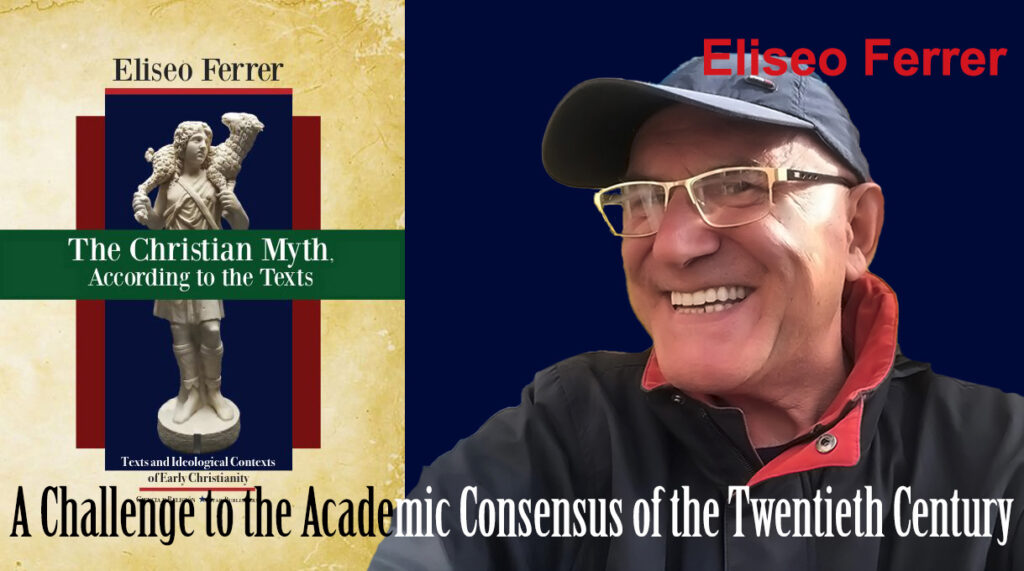
Against those who claim that Jesus was a Jewish eschatological prophet, I must insist that certain intertestamental apocalyptic texts of Hellenized Judaism, prior to the gospels, speak of the Anointed One and the Son of Man, but none of them speak of “their” Jesus or “their” Jesus Christ. Against those who claim that the gospel hero was a Jewish apocalyptic prophet temporally located within Herodian history—and having adopted the threefold argument of the original Christian scheme I just outlined (multiplicity of independent Christian traditions, temporal primacy of gnosis, and later incorporation of apocalyptic mythology into the New Testament narrative)—I must again insist and emphasize that Hellenistic apocalypticism (Persian, Greek, and Jewish) was incorporated into Christian texts late, after the mysticism of the first-century speculations of Christian gnosis. Let it be clear, therefore, that, according to the texts, the syntagm “Joshua–Jesus” (Yehoshúa–Yeshúa) appeared linked, as Savior, to the writings of primitive Christian gnosis; while the syntagm “Anointed–Christós” was presented as the referent of the primitive eschatological Judge of the Hellenistic intertestamental apocalyptic literature.
All of this is developed in this work through a thematic structure that includes a first part, in which the cultural and ideological-textual foundations of the myth of the celestial savior are presented. In the second part, I introduce “the Christian myth in evolution”; or, to be more precise, what we can also call “the convergence of currents in Christian mythology,” which includes:
- the myth of the judge-savior (Saoshyant) from Persian apocalyptic literature, who makes his appearance on earth (parousia) to declare the end of time and carry out the universal judgment of the living and the dead;
- the Orphic–Platonic myth of Greek origin (Dionysus), involving the incarnation of divinity in the soul, serving as the central and ideologically preeminent space of Christian mythology; and
- the Orphic–Platonic myth expanded with the stereotypes of Pauline mysteriology: the myth of the descent, incarnation, death, and resurrection of the Son of God.
And finally, I dedicate the third and last part of the work to what I call “the controversial construction of ecclesiastical Christianity,” or apostolic Christianity, from which Catholic Christianity would later emerge. In other words: the controversial, disputed, and radical transformation of the Greek and Hellenistic mysticism of early Christianity, through its Judaization, carnalization, and historization by the Church; through the appropriation of the texts of the Jewish Scriptures from the Greek Bible of Alexandria; and through a deadly confrontation with the other currents of ancient Christianity. All of which gave rise to the expiatory soteriology of redemption through suffering and spilled blood; to the fusion of the proto-gnostic Savior with the Suffering Servant of Isaiah; and to the dual myth of the “true God and true man,” which, from the theology of the Church, was presented as a radical negation of all mythology.
As a conclusion, I must say that this work positions itself in radical confrontation with that laughable academic consensus which, throughout the second half of the last century, accepted (academically speaking) the false historical, carnalist, and Judaic foundations of the ecclesiastical fabulation. A fable that was nothing more than the result of power struggles and a literal and simplistic reading of the allegorical narratives of the three great myths I have discussed: the Greek myth of incarnation, the Hellenistic–Persian eschatological myth, and the mystery myth of death and resurrection. No… Christianity was not born in the manger of Bethlehem or in a carpenter’s workshop in Nazareth, as many anachronistic and misinformed professors still try to make us believe today. No… Christianity was not “a heresy of Judaism” either, as Justin Martyr suggested in his Dialogue, in a language that blatantly revealed the manipulation of the text and the ideological Judaization of original Christianity. Nor was it a uniform cultural movement that emerged as a consequence of the development of a Jewish seed, nourished and sustained by the longing for universality and spirituality manifested in fleeting flashes of Jewish prophetic literature. As we will see in this work, neither was Jesus a Jew—according to the texts—nor was Jesus a man of flesh and blood, nor did Jesus ever dwell in the rugged terrain of history. The original Christianities formed an enormously heterogeneous universe, the result of the complexity inherent to Hellenism: the result of independent currents of Hebrew–Samaritan, pagan, Alexandrian, and Judeo-Hellenistic origin; all of them united by the common denominator of the myth of the incarnation of the Savior in the human soul—of Orphic and Dionysian origin—and, secondarily, some of them also united by the myth of the presence of the judge-savior of end-times eschatology.
In short, and as we will see in this work, one thing was Christianity, and quite another was the ecclesiastical Christianity (apostolic and Catholic) created in the second half of the second century. That is to say, primitive Christianity—of multicultural and mythical origins—was one thing, and the later Christianity of the Church, anticipated in the work of Justin Martyr and objectively manifested in the work of Bishop Irenaeus of Lyon, was another. The former belonged to the various Gnostic (Orphic–Platonic) and eschatological (apocalyptic) sects of the early first century; and the latter, very different, was the Christianity that Judaized, made flesh, and historicized the Greek myth in order to present Jesus Christ as “true God and true man,” announced in the Jewish Scriptures.
Eliseo Ferrer / The Christian Myth, According to the Texts. (Texts and Ideological Contexts of Primitive Christianity).
© Desde na antropología materialista.
